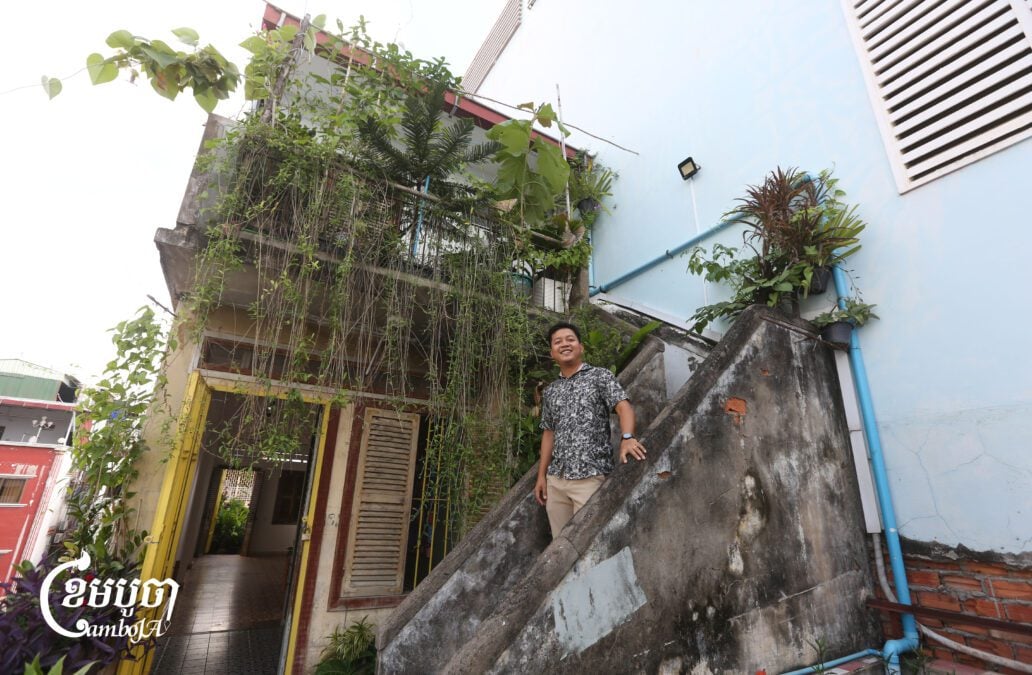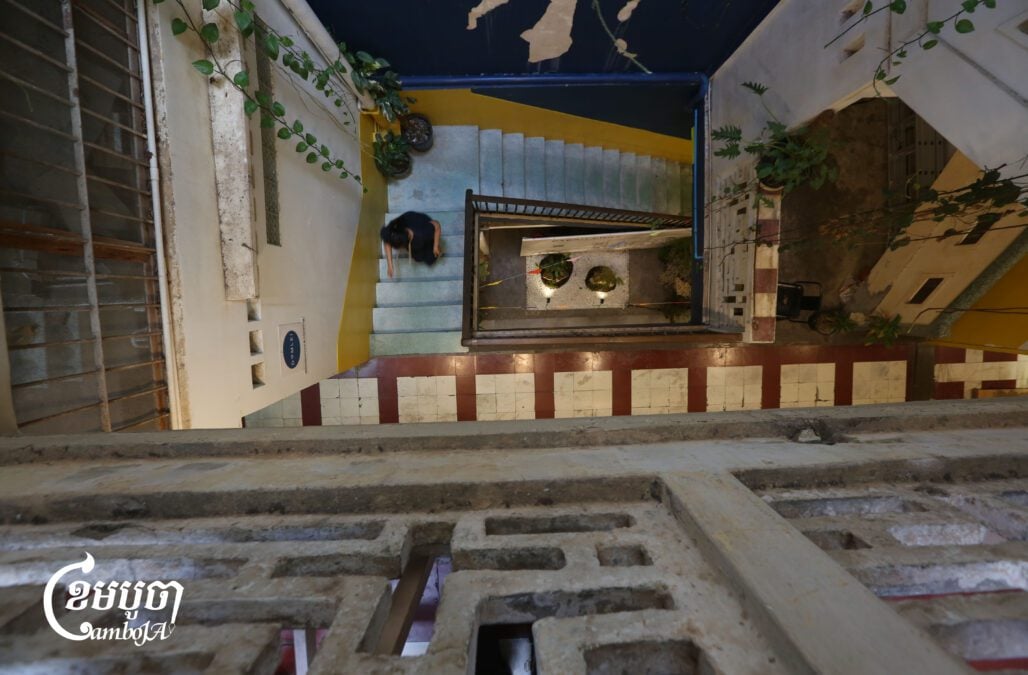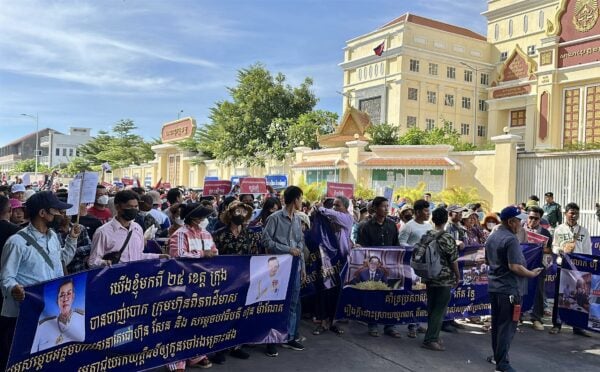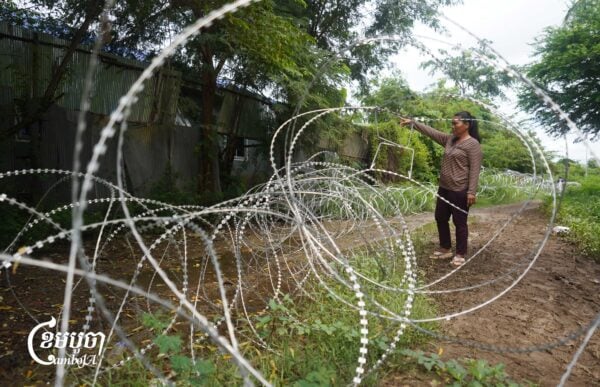In the shadow of gleaming high-rises in downtown Phnom Penh, the 75-year-old Nokor Meanchey building stands weathered and near-empty, marked for demolition over concerns about its structural integrity.
Built just before Cambodia gained independence from France, the timeworn former hotel was later converted into co-owned housing. At its peak, it was home to 65 families.
But in May, the Ministry of Land Management declared the building unstable, triggering a 15-day deadline to vacate before demolition protocols could begin. Most residents accepted government compensation and left. Four families remain, saying they are holding out over what they see as inadequate payouts – despite the risks of living and working in a structure marked for collapse.
With Nokor Meanchey now officially sealed off and potential developers already circling, the case underscores the growing tension between rapid urban development and heritage preservation. Local architects, entrepreneurs and urban geographers warn that without stronger preservation laws, planning and investment, Cambodia – particularly its capital – risks losing much of its historic architecture and the cultural identity it carries.
They are calling for a paradigm shift in the country’s approach to urban growth.

Sokagna Hun, an independent architect based in Phnom Penh, said many of the city’s older buildings, including those from turbulent chapters in its past, carry deep social, economic and cultural value. But much of that built heritage, she said, has already been lost to unchecked development.
Shaped by a complex history of colonial rule, civil conflict and authoritarian regimes, Cambodia is dotted with aging structures that have withstood generations. A 2016 study by French researchers identified 523 French colonial buildings in Phnom Penh – 448 of them residential. How many remain today is unclear.
Sokagna explained that preserving these buildings remains a major challenge, largely due to the absence of proper law and the lack of technical expertise necessary for maintenance and restoration.
Most older buildings in Phnom Penh currently fall under a collective ownership structure that makes renovation especially difficult. Sokagna said any major repairs must be legally approved and agreed upon by all owners. If even one household objects, the project cannot move forward. Funding is another major hurdle, with many residents unable to afford the high costs of renovating aging properties.
“The first problem is that there is no adequate repair law. If someone living in a collective building wants to renovate, they have to submit a proposal with the government first,” she said. “The second is that the government doesn’t allocate funds and the residents often can’t afford it.”

According to Cambodia’s Law on the Protection of Cultural Heritage, buildings or objects deemed to hold historical, artistic, scientific or religious value can be registered as cultural properties – even if they are not formally classified. Once listed, owners must notify authorities at least one month before relocating, repairing, altering or demolishing the property.
Several residents of the Nokor Meanchey building said they never applied for such protection.
Beyond legal and financial barriers, Sokagna stressed the need for greater public participation in urban heritage planning, which requires navigating the sensitivities of Cambodia’s colonial past and challenging the preservation-versus-progress myth.
Sokagna said community involvement and public appreciation for Phnom Penh’s historic buildings remain limited, warning that without a clear urban planning policy balancing preservation and development, rapid expansion risks erasing the city’s architectural legacy.
Authorities, she said, must designate zones for modern construction and protect core areas where old buildings should stand. Phnom Penh’s current master plan falls short, lacking clear rules on high-rise development in the city center.
Many of Phnom Penh’s most recognizable historic buildings, blending French colonial style with Khmer motifs, cluster along major thoroughfares such as Monivong and Norodom boulevards.
But as of this year, the skyline includes more than 453 apartment complexes and nearly 1,880 high-rises, according to Phnom Penh’s deputy governor, Keut Chhe.
Milena Wald, an urban geographer, has written extensively on Cambodia’s challenges in weaving heritage conservation into city planning.

Like Sokagna, she said colonial-era buildings in Phnom Penh and other cities are often viewed as relics of a painful past and are rarely prioritized for preservation.
That ambivalence, coupled with weak institutional capacity and corruption, has left development largely in the hands of private interests.
The result, she said, is the steady demolition or modernization of historic buildings, often with little public awareness or opposition.
One of the most prominent examples of this trend was the demolition of the iconic “White Building” in 2017. Completed in 1963, the structure stood on Sothearos Boulevard in central Phnom Penh and was a landmark of New Khmer Architecture, designed by Cambodian architect Lu Ban Hap and Ukraine-born French engineer Vladimir Bodiansky. Architects and historians hailed it as a pioneering symbol of Cambodia’s 1960s modernist movement.
That brief architectural identity emerged during Cambodia’s “golden era” under Prince Norodom Sihanouk, when the country underwent rapid modernization before descending into civil war and genocide. Architects such as Ban Hap and Vann Molyvann shaped this movement with bold designs that fused modernism and Khmer elements. Many of these distinctly Cambodian buildings have also been neglected or lost amid growing urban development pressures.
Despite its cultural value, the White Building was razed by the Ministry of Land Management, Urban Planning and Construction. At the time, officials said a Japanese construction firm would replace it with a more than 21-story complex backed by more than $70 million investment.
Those plans have since shifted. The site is now being developed as part of NagaWorld III, an extension of Phnom Penh’s casino and hotel complex.

A spokesperson for the Ministry of Land Management, Urban Planning and Construction did not immediately respond to requests for comment about Nokor Mean Chey, its remaining residents or demolition plans.
One possible solution to saving old architecture, experts say, is to reframe it as a tourism asset.
So Phina, director of the Cultural and Creative Industries at the Cambodia Association for Development and Advocacy (CICADA), said historic buildings can be turned into public, visitor-friendly spaces if supported by both public and private partners. She said the model has worked in other countries.
Many of these buildings already serve as homes and small businesses, she added, showing their economic potential. Phina called for a collaborative process involving government engineers, artists, local communities, donors and investors.
She suggested introducing creative venues such as cafes, bookstores or clothing shops to attract foot traffic.
“When all that is in place, tourists will come and use those services. The income goes to the people, it helps the economy, and we’ve preserved the buildings so they don’t fall apart,” she said.
Still, she noted, success requires time, investment and coordination. Without strong leadership, only the government can guide and encourage investment in the sector.
Some entrepreneurs have already taken matters into their own hands.

Hem Chan Sopheak, a founder of the Pteah Chas Community business center, runs a flower and coffee shop alongside a souvenir store in a building built in 1953 near Phnom Penh’s riverside.
He saw opportunity in the neglect of buildings like Pteah Chas, and called for stronger government support to preserve them.
“The government should issue more policies and laws to protect old buildings, including budget allocations to help residents repair and maintain them,” he said. “They could also designate heritage zones as tourist areas to boost both the national and local economy.”
Sopheak said such measures would support jobs and tourism while preserving the historical value embedded in Phnom Penh’s aging architecture.













